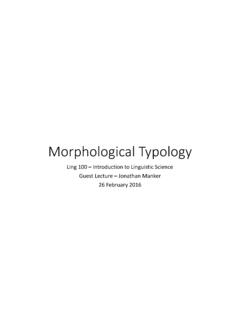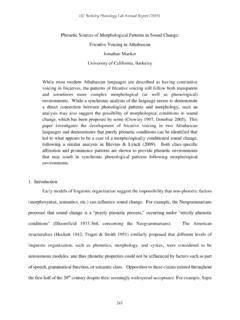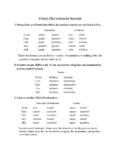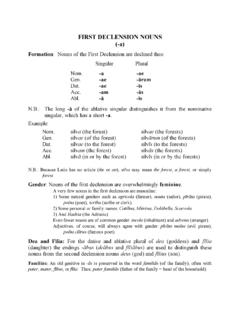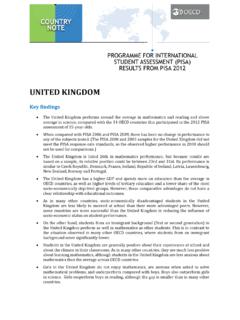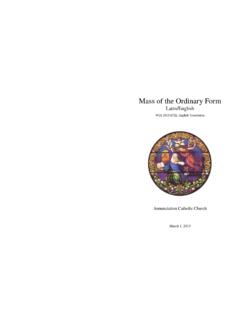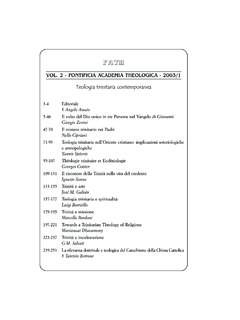Transcription of The Morphology-Phonology Connection - Linguistics
1 The Morphology-Phonology Connection SHARON INKELAS. University of California, Berkeley 1. Introduction This paper addresses several general issues in the Connection between morphology and phonology , where morphology is understood to involve generalizations about form and meaning that relate words to one another within a language, and phonology is understood to involve generalizations about the sound patterns in that language. morphology and phonology intersect insofar as the statement of morphological generalizations includes information about sound patterns (realizational morphology ), and insofar as the statement of phonological generalizations includes information about morphology (morphologically conditioned phonology ). This intersection is extensive, blurring the distinction between morphology and phonology in many situations. The recent literature features three approaches which focus squarely on the Morphology-Phonology interface: Cophonology Theory (Orgun 1996, Inkelas et al.)
2 1997, Inkelas 1998, Anttila 2002, Inkelas and Zoll 2007), Stratal Optimality Theory (Kiparsky 2000;. 2003b; a), and Indexed Constraint Theory (McCarthy and Prince 1995, Pater 2000, It and Mester 1999, Alderete 2001, and Smith 1997). This paper argues that Cophonology Theory succeeds best of the three in capturing three generalizations that unify morphologically conditioned phonology and realizational morphology : SUBSTANCE: Morphologically conditioned phonology and realizational morphology involve the same operations SCOPE: Morphologically conditioned phonology and realizational morphology have identical scope of application within a word LAYERING: Morphologically conditioned phonology and realizational morphology are identical in their interactions in complex words Sections 2 and 3 introduce examples of morphologically conditioned phonology and realizational morphology , and Section 4 introduces the theories being compared.
3 SUBSTANCE, SCOPE and LAYERING are discussed in sections 5-7. 1. 2. Morphologically conditioned phonology Morphologically conditioned phonology is the situation in which a particular phonological pattern is imposed on a proper subset of morphological constructions (affix, reduplication, compounding) and thus is not fully general in the lexical phonology of the language. We will see three examples here. In Mam, suffixes partition into two classes (Willard 2004, based on England 1983). Dominant' affixes cause long root vowels to shorten (1a); Recessive'. suffixes preserve root vowel length (1b). Dominant vs. recessive status is not predictable; it must be learned individually for each affix. (1) a. Dominant suffix: shortens long root vowel facilitative liich'- lich'-ich'iin break/breakable'. resultant juus- jus-b'een burn/burned place'. locative directional jaaw- jaw-nax go up/up'.
4 Participial nooj- noj-na fill/full'. b. Recessive suffix: preserves root vowel length intransitive muq- muq-oo bury (n.)/bury (v.)'. verbalizer b'iitz- b'iitz-oo [b'liitza] song/sing'. instrumental luk- luk-b'il pull up/instrument for pulling up'. remainder waa- waa-b'an eat/remains of food'. In Malayalam, gemination applies at the internal juncture of subcompounds (compounds with head-modifier semantics) (b) but not at the internal juncture of cocompounds (with coordinate semantics) (c) (Mohanan 1995:52): (2) a. mee a table' pet. t. i box'. kasaala chair' -ka (plural suffix). b. [mee ]S ka boxes made out of tables'. c. [mee a-pet. t. i]C -ka tables and boxes'. In English, suffixes fall into two classes (Allen 1978, Siegel 1974, Chomsky and Halle 1968, Kiparsky 1982a): those which shift stress and those which do not. (3) Base Stress-shifting suffix Non-stress-shifting suffix p rent par nt-al p rent-ing pr sident pr sid nt-ial pr sidenc-y ctive ct v-ity ctiv-ist d monstr te demonstrative d monstr tor 2.
5 In all three of these examples, some morphological constructions in the language (affixation, compounding) are associated with a pattern that other constructions (other affixation, other compounding) are not. 3. Realizational morphology Realizational (or process) morphology is the situation in which a morphological category is exponed by a phonological process other than concatenation of segmental morphemes. Three clear examples are cited below. In Tohono O'odham, a well-known process of subtractive morphology derives perfective verbs from imperfectives by deleting a final segment. Before a final coronal consonant, a high vowel deletes as well. Examples come from Yu (2000:129-30), citing Zepeda 1984, and Anderson (1992), citing Zepeda 1983: (4) Imperfective Perfective gloss data source s kon s ko hoe object' Yu 2000. h wa h w rub against object' Yu 2000. hi nk hi n bark' Anderson 1992.
6 In Keley-i (Malayo-Polynesian), nonperfect aspect is marked by consonant gemination, providing a coda to what would otherwise be the leftmost light syllable (Samek-Lodovici 1992, citing original sources) (5a-c). In a word with all closed (heavy) syllables (5d), gemination is blocked. (5) (a) (b) (c) (d). Base: pili duyag agtu duntuk Subject focus: um-pilli um-duyyag Man- agtu um-duntuk Object focus: pilli duyyag agtu duntuk Access. focus: i-ppili i-dduyag i- agtu i-dduntuk English provides a familiar third example: stress shift marks the conversion from verbs to nouns in English ( Kiparsky 1982b): (6) cond ct c nduct abstr ct bstract rec rd -> r cord 4. Sketches of three approaches to morphologically conditioned phonology We turn next to a brief presentation of three theories designed to cover morphologically conditioned phonology . For maximum comparative effect, and given the limited space available, it is necessary in these sketches to portray the strictest version of each theory, ignoring nuanced variations of each.
7 3. Cophonology theory In Cophonology theory (Orgun 1996; Inkelas et al. 1997; Inkelas 1998; Anttila 2002), a member of the family of construction grammar theories (Goldberg, et al.), the morphological grammar consists of a set of word-building constructions. Each construction embodies both a meaning function, which could be inflectional, derivational, or even the identity function, as well as a form function (cophonology), a set of ordered phonological rules or ranked constraints. For example, the ify construction in English is associated with a meaning function that takes a nominal stem as input and produces an output whose form is predictable from the form of the input by means of a phonological mapping that concatenates the stem with the string ify and performs such phonological operations as (re)syllabification, stress shift, Trisyllabic laxing, and velar softening.
8 In (7), only the form function is denoted, as f(x), where f represents the cophonology and x represents the phonological form of the input string(s). (7) [Phon = f(x)] [op cify]. [x] -ify [opaque] -ify The cophonology of the comparative er suffix in English differs from the cophonology of ify in numerous ways: it is stress-preserving, not stress-shifting;. it requires roughly monosyllabic inputs; it does not trigger Trisyllabic laxing or velar softening. In cophonology theory, each individual morphological construction has its own, potentially unique, cophonology; similarities among the cophonologies of constructions in the same language are captured with meta- generalizations formalized as a grammar lattice' in Anttila 2002. Precedents for cophonologies can be found in Poser 1984 and Bochner 1992. Stratal Optimality Theory (Kiparsky 2003b). A descendant of Lexical morphology and phonology (LMP; Kiparsky 1982), Stratal OT posits that every language has three strata, each with its own phonological system: (8) Stem stratum.
9 Word stratum . Postlexical stratum In Stratal OT, the phonological differences between ify and er would be modeled by assigning ify to the Stem stratum, which imposes resyllabification, stress shift, Trisyllabic laxing and velar softening, and -er to the Word stratum, which imposes only resyllabification. Stratal OT thus can be characterized as a 4. very restrictive version of cophonology theory in which every morphological construction is associated either with the Stem' or the Word' cophonology. Indexed constraint theory Unlike Cophonology theory and Stratal OT, both of which assume that a language can have multiple cophonologies, Indexed Constraint theory assumes a single phonological grammar for each language. Because Indexed constraint theory was formulated within OT, it is always discussed with reference to OT. constraints, though it also resembles the rule-based theory of The Sound Pattern of English (Chomsky & Halle 1968), which assumed a fixed set of general rules for each language, plus a contingent of minor rules indexed to particular lexical or morphological contexts.
10 In Indexed Constraint Theory, morphologically conditioned phonology is handled by indexing constraints to individual morphological contexts, Max-Croot, Max-Caffix, Max-CBR, etc. Proponents include McCarthy and Prince 1995; Smith 1997, It and Mester 1999; Pater 2000, 2006; and Alderete 2001, among others. With this brief introduction to the three theories being compared, we now test them, using evidence from realizational morphology and morphologically conditioned phonology , against the SUBSTANCE, SCOPE and LAYERING. generalizations, to be motivated in the following sections. 5. SUBSTANCE. The SUBSTANCE generalization holds that realizational morphology and morphologically conditioned phonology overlap substantively to the point of being essentially indistinguishable. In a brief tour below, we will see seven different phonological effects, each instantiated once as realizational morphology and once as morphologically conditioned phonology .
